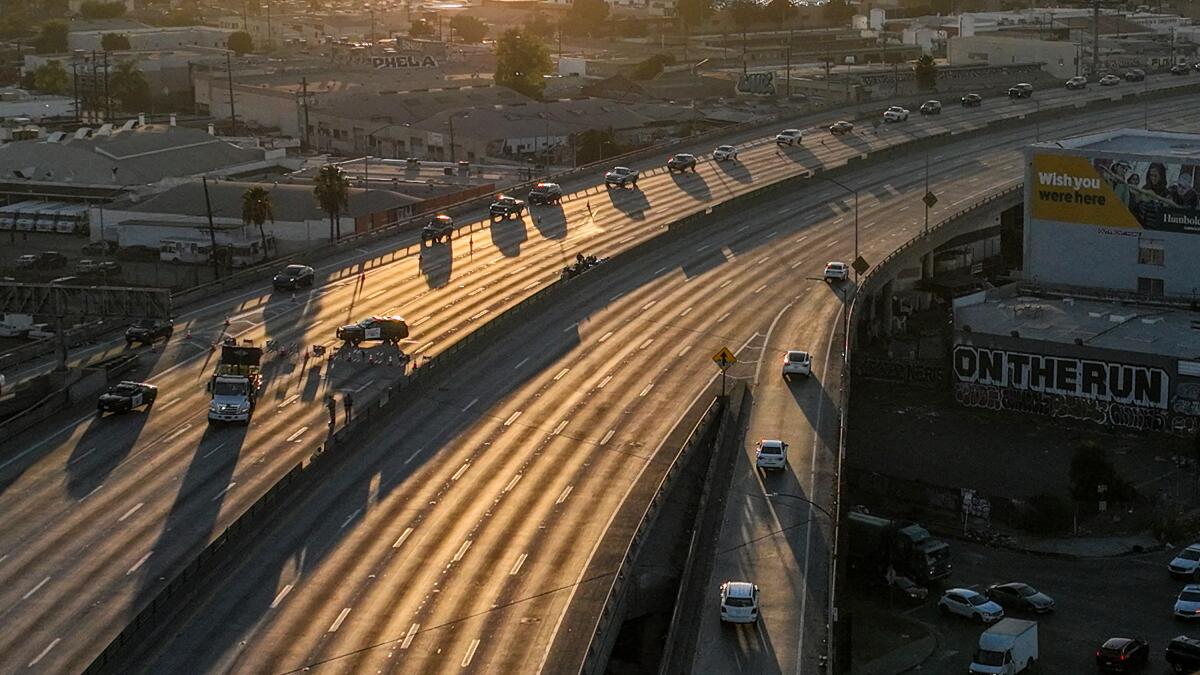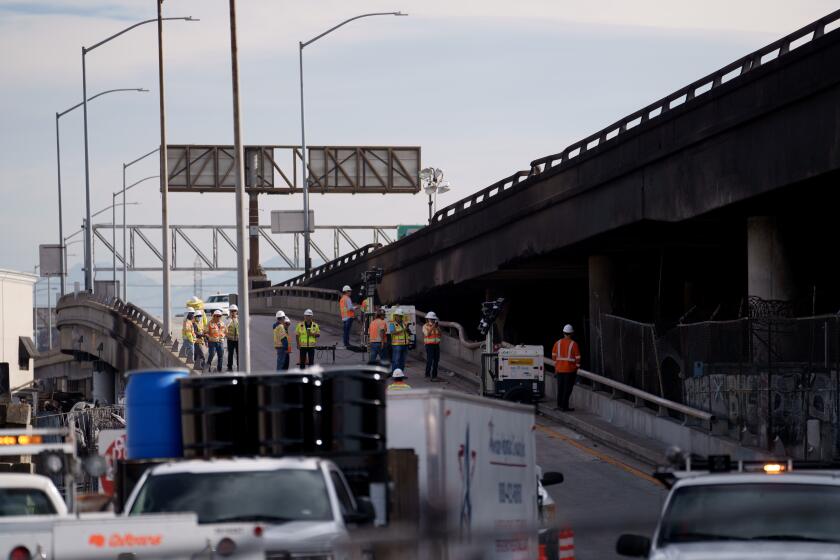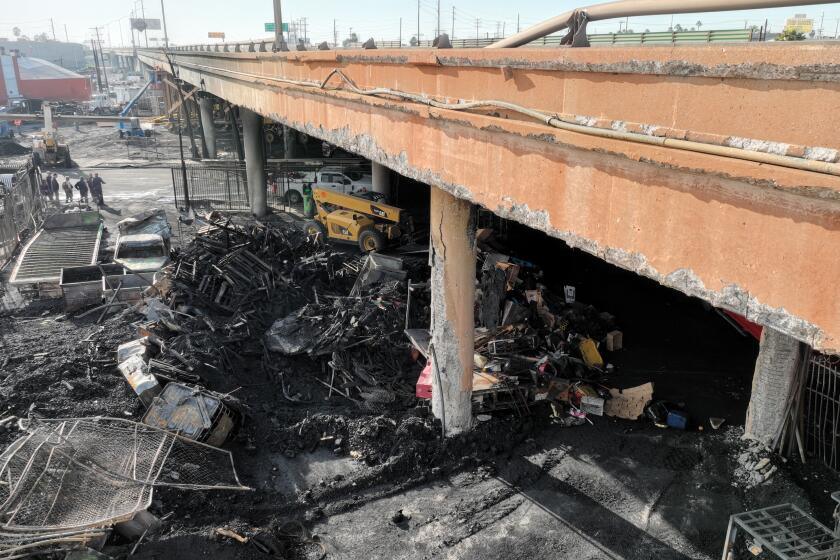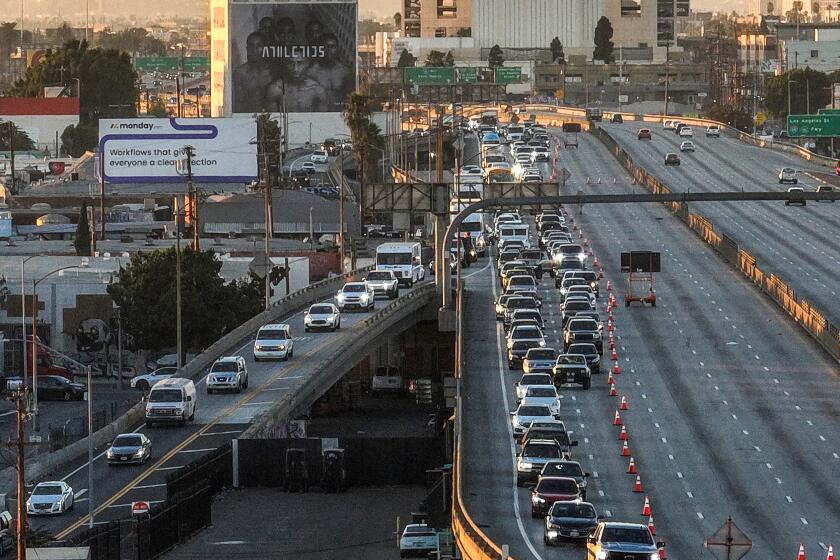‘Go faster. The political heat is on.’ Inside the race to fix the 10 Freeway in L.A.

- Share via
In the days after a huge pallet fire shut down one of the busiest traffic corridors in the nation, Gov. Gavin Newsom delivered bittersweet news: The damaged section of the 10 Freeway in downtown Los Angeles would not need to be demolished, but repairs would leave it out of commission for three to five weeks.
Publicly, state officials stood by that timeline for most of this week, saying the freeway was likely to reopen in December. But behind the scenes, according to a Caltrans engineer familiar with the project, crews were scrambling to hit a more ambitious target and have the overpass ready for Thanksgiving travel.
The work paid off, and on Thursday, Newsom confirmed what the Caltrans crews had been working toward: All lanes in both directions will be open to traffic by Tuesday “at the latest,” he announced, though repair work will be ongoing.
“Things continue to move favorably in our direction,” Newsom said. “The bridge structure itself seems to be in better shape than we anticipated.”
Gov. Gavin Newsom announced Thursday that the fire-damaged 10 Freeway will be reopened sooner than expected — Tuesday “at the latest.”
The quick reopening does not mean any corners have been cut, L.A. Mayor Karen Bass said Friday.
“Let me just assure you that the reason why the freeway is going to be open quickly is because the deep structural damage that we were worried about did not take place,” she said at a news conference. “There isn’t any reason to doubt that this freeway would not open if there was any concerns about safety.”
While state officials turned on live camera feeds from the construction site on Friday, the agency responsible for the repairs has provided little information about the work. The California Department of Transportation declined a request from The Times for an interview about the repairs and how the timeline for reopening shifted so drastically.
The fire, which started early Saturday at a property leased from Caltrans where wood pallets were being stored under the 10, caused less structural damage than anticipated, Caltrans said in a news release Friday. The mile-long section of the freeway between Alameda Street and the East Los Angeles interchange is now shored up with wooden posts and steel beams, which officials said will allow the overpass to open to traffic while crews work to repair damaged concrete columns and the upper deck.
With a surge of holiday traffic expected through a freeway corridor that averages about 300,000 commuters a day, the message was clear from the beginning, said the Caltrans engineer who was not authorized to speak publicly and requested anonymity:
“Go faster. The political heat is on.”
Caltrans routinely inspected the site where the fire broke out and last visited Oct. 6. The company that rented the land from Caltrans said it’s being scapegoated.
There has been “a dead-heat, crazy push to get this bridge open by Monday or Tuesday,” the engineer said.
Lights are being fixed, the concrete guardrail is being patched, shoring continues to be installed, and jacks are starting to take the weight off damaged columns, according to the engineer.
When asked why the state had estimated the closure would drag into December, the engineer was puzzled.
“I can’t fathom that they would want this major interstate to be closed going into Thanksgiving,” the engineer said.
Within hours of the fire, engineers went to work calculating the combined load of the freeway and the vehicle traffic that would need to be supported if shoring was installed, which Caltrans does regularly when repairing bridges in its statewide system of highways and roads.
The design for the shoring — the number of timber posts, their size and spacing — is “highly redundant and conservative,” and has been reviewed by contractors and Caltrans experts, the engineer said, noting that the overpass will be safe to drive on.
About eight timber posts are being used to support each damaged freeway column. Forty-five columns have been identified as damaged.
After clearing about 264,000 cubic feet of hazardous material and debris, including more than two dozen burned vehicles, crews have begun to maneuver the enormous timber posts in place under the freeway. Measuring 12 inches by 12 inches, they stand 20 feet tall, five feet apart, on a beam that’s supported by hydraulic jacks, which will raise the vertical posts against the underside of the freeway to take the weight off the damaged columns.
Once all of the weight is taken off those columns, the freeway can be reopened by Caltrans’ Structural Maintenance and Investigations division. Designs for specific repairs of the columns will follow, to be reviewed by seismic and construction experts.
Caltrans was trying to evict the company leasing the lot that caught fire and severely damaged the 10 Freeway. Agency says it illegally sublet the property to several small businesses.
There is precedent for such freeway repair and reconstruction projects coming in ahead of schedule.
In 1994, after a section of the 10 Freeway collapsed when the Northridge earthquake knocked out two bridges at La Cienega and Washington boulevards, round-the-clock repairs got vehicles back on the freeway in less than three months.
In 2017, combustible materials stored under Interstate 85 in Atlanta caught fire, causing a portion of the freeway to collapse, snarling traffic for six weeks. That incident led Caltrans to write a policy directive that prohibited the storage of flammable materials under its bridges and required access for bridge inspections.
This year, a tanker truck carrying gasoline crashed beneath Interstate 95 in northeast Philadelphia, starting a fire that collapsed the overhead steel bridge. Experts predicted repairs would take months, but within 12 days, the freeway was open again, missing only one lane of traffic. The reconstruction was live streamed, playing in local bars and even on the scoreboard during a Phillies game.
“There has been an evolution in engineering circles,” said Thomas Gernay, an assistant professor of engineering at Johns Hopkins University who studies the effects of fire on structures, “from focusing on life safety — the primary goal [being] to make sure people are safe — to [including] the concept of resiliency: to make sure infrastructure is able to absorb shocks with minimal disruption and rebound … as fast as possible.”
Building such resilience into structures that were designed years ago requires an assessment of both the structure and its materials as well as the impact — economic, functional — if the structure was lost.
Neither seems to have taken place in the case of the 10 Freeway.
“Why are we allowing for major storage — be it wood crates or isopropyl alcohol — under a freeway or a bridge? It doesn’t make sense to me as an engineer,” said Nate Wittasek, a fire protection engineer with Simpson, Gumpertz and Heger. “Either the assessments aren’t being done, or there is a lack of understanding of the potential for damage from the material or fuel storage near these highways or bridges.”
The fire, which arson investigators believe was intentionally set, was fueled by wood pallets stored on a Caltrans property being leased to a private company and subleased to small blue-collar businesses.
How Caltrans evaluates its policy of leasing space underneath freeways in the aftermath of the fire is unknown.
Risk analyses need to be conducted to evaluate the safety of these leases, Gernay argued, adding that because real estate is expensive, there is a compelling reason to continue the practice of leasing the space — if resilience is built in.
“Resilience is a very important, desirable feature of design,” said Ali Ashrafi, a structural fire engineer with Thornton Tomasetti. “Sometimes it is codified, but more often than not it is not codified.”
Ultimately it comes down to what the stakeholder wants and how important the structure is.
“We’re not designing for zero risk but to minimize risk to a level that is acceptable to society,” Ashrafi said. “The goal of the design is to have an acceptable level of risk, from a building to a bridge to a tunnel. That acceptable level could change depending on the consequences of a failure.”
After a massive fire shut down a vital section of the I-10 near downtown, city officials are finding ways to persuade Southern Californians to take public transit.
Before the 10 reopens, bottleneck conditions persist around the detour routs — and several events in and around downtown Los Angeles could strain roadways.
The Clippers played Friday evening at Crypto.com Arena, and the Los Angeles Kings will play there Saturday, while USC and UCLA will meet at the Coliseum for a football game. The Lakers play at home Sunday, while the Los Angeles Convention Center plays host to the L.A. Auto Show.
Officials encourage anyone making their way to downtown to take public transportation or, if possible, steer clear of the area.
“Please avoid traveling to downtown Los Angeles,” Caltrans district traffic manager Dyari Ahmed said during a Friday morning news briefing. “If you can tell your work, please do so. Postpone discretionary trips into the downtown area.”
To help ease congestion, the Los Angeles Department of Transportation has stationed white-glove traffic officers at intersections encountering heavy traffic, and Commuter Express buses are free through the end of the year.
Times staff writer Ashley Ahn contributed to this story.
More to Read
Sign up for Essential California
The most important California stories and recommendations in your inbox every morning.
You may occasionally receive promotional content from the Los Angeles Times.



















